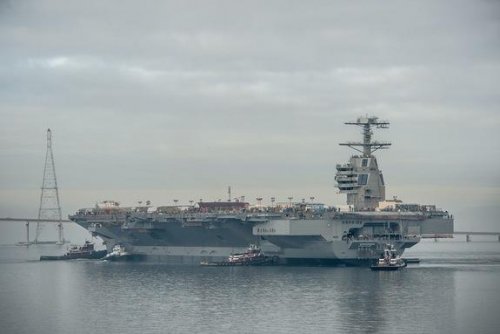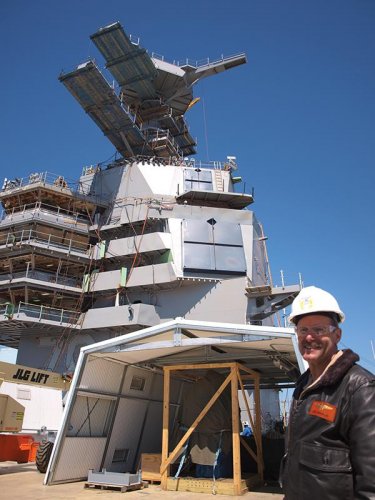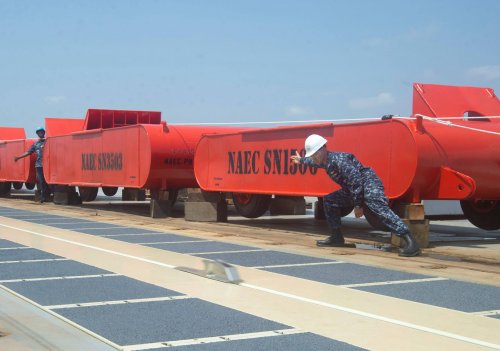WASHINGTON — The US Navy’s newest aircraft carrier, a multibillion-dollar behemoth that is the first in a next generation of carriers, is beset with a number of performance problems, even failing tests of its ability to launch and recover combat jets, according to an internal assessment by the Pentagon.
The early tests are raising worries that the USS Gerald R. Ford, christened in honor of the 38th president in November, may not meet the Navy’s goal of significantly increasing the number of warplanes it can quickly launch — and could even be less effective than older vessels. The carrier is undergoing testing at a Virginia shipyard and is scheduled for delivery to the Navy in 2016, with a price tag estimated at more than $12 billion.
At least four crucial components, which are still being installed on the ship, are at risk because of their poor or unknown reliability, states the 30-page testing assessment, which was delivered last month to Secretary of Defense Chuck Hagel and other top Pentagon leaders.
In addition to the ship’s launching and landing systems for jet fighters, officials are also concerned about its advanced radar system, which is being produced by Waltham-based Raytheon Company. It also remains unclear if a key weapons elevator will work as promised.
“Poor reliability of these critical systems could cause a cascading series of delays during flight operations that would affect [the ship’s] ability to generate sorties, make the ship more vulnerable to attack, or create limitations during routine operations,” according to the report, a copy of which was obtained by the Globe.
A number of other systems, such as communications gear, meanwhile, are performing at less than acceptable standards, according to the assessment by J. Michael Gilmore, the Pentagon’s director of operational test and evaluation. Gilmore concluded that the Navy has little choice but to redesign key components of the ship.
Rear Admiral Thomas J. Moore, the program executive officer for aircraft carriers, defended the progress of the ship in an interview and expressed confidence that, in the two years before delivery, the Navy and its contractors will overcome what he acknowledged are multiple hurdles.
“With these new technologies comes a lot of developmental challenges,” said Moore, an MIT-trained nuclear engineer. “We disagree with the characterizations of the risks. The ship . . . is going to be a fantastic ship that will provide capabilities [the current fleet] doesn’t have.”
But the Navy declined to discuss specifics of the assessment, saying it was an internal document and has not been made public. It also could not say how the problems might affect the delivery schedule, cost, or combat effectiveness. The ship’s primary contractor, Newport News Shipbuilding, also declined to discuss the findings of the report.
“We are going to defer to the Navy on the report,” said Christie R. Miller, a spokesperson for its parent, Huntington Ingalls Shipbuilding.
The ship has had its share of critics in the past. The Government Accountability Office, the investigative arm of Congress, found last year that the cost of producing the ship had risen 22 percent from original predictions.
The Accountability Office recommended delaying construction of the second ship in the class, the USS John F. Kennedy, until the Navy and its contractors have a better handle on a series of untried technologies.
A third vessel in the new ship class, the USS Enterprise, is in the works, and the Navy could buy up to eight more vessels.
At 1,106 feet, the Gerald Ford class ships are the first newly designed carriers in more than 30 years. The prototype has 25 decks and is 250 feet high. The carriers are intended to replace some of the 11 Nimitz class aircraft carriers that debuted in the 1980s.
Most new Pentagon weapons systems encounter development and engineering problems. In this case, the Navy still has two years before scheduled delivery to work on solutions.
But Gilmore’s assessment, which was based on a yearlong evaluation of the Gerald Ford ending in September 2013, is the strongest indication yet that the Navy may be falling short of its goal of increasing the number of combat flights that can be flown from an individual ship.
About 60 percent of the ship, which like its predecessors will be nuclear powered, is based on the Nimitz design, while the remaining 40 percent consists of entirely new components — including a larger flight deck and high-tech systems. It is many of those new technologies that are encountering serious problems, Pentagon leaders have been told.
Primary among them is the so-called electromagnetic aircraft launch system, which is replacing the steam-powered catapult system long used to launch jets off the deck. The new system features a 100,000-horsepower linear electric motor, with a slide that accelerates along a giant rail. It has the ability launch multiple planes, one after the other, at a rapid pace.
Land-based tests of the system in New Jersey have demonstrated a reliability rate of only 240 launches without a failure, when it should be above 1,250 launches without failure at this stage of the Gerald Ford’s development.
Meanwhile, a companion system, known as the advanced arresting gear, which is designed to safely snare landing aircraft with cables stretched across the deck, is similarly unreliable, according to the report. In the tests, the system of cables has averaged 20 successful landings without failure. That is far less than the 4,950 successful landings it should be achieving without failure. The ultimate goal is for the system to work 16,500 times without failure.
Unless the various problems are resolved, the Pentagon weapons testers warned, the Gerald Ford will not be able to fly the number of wartime sorties envisioned by Navy planners, and two carriers might be needed to achieve the same effect of one.
The launch and landing systems are both being built by California-based General Atomics. Gary Hopper, vice president at the company, declined to respond to questions.
“I would defer your questions to our customer,’’ he said. “It is not our policy not to speak for the Navy on this program or others.”
Ronald O’Rourke, a naval analyst at the Congressional Research Service and an expert on shipbuilding programs, said the first ship in a new class traditionally faces significant technological challenges and cost growth.
“Lead ships tend to be difficult,” he said. Still, he added, “the number of new technologies on this ship is not extraordinary.”
Admiral Moore did not address directly the Pentagon’s concerns about the new launch and recovery systems but said the technology was not so futuristic that problems cannot be solved.
“This isn’t like a laser or a proton torpedo,” he said, noting that similar power systems are used to run roller coasters at amusement parks.
But he acknowledged the amount of electric power the Navy needs to generate to launch and recover hundreds of planes each day on the deck of an aircraft carrier at sea is unique.
“On the scale we are talking about, we haven’t done this before,” he said.
The assessment also raised concerns about the progress of the so-called dual band radar that Raytheon’s Integrated Defense Systems and Advanced Technology division in Rhode Island is helping design.
The radar, which is currently being tested along the Virginia coast, is supposed to be able to multitask: conduct air traffic control, scan the skies and the horizon for potential threats, and gather target data that can be fed into the computers of weapons systems.
“There is little information on reliability,” the assessment concludes about the new radar, even though an estimated 86 percent of the system’s components have already been delivered to the Navy. Raytheon did not respond to requests for comment.
Moore, however, said the Navy remains confident in the new radar, although he acknowledged that testing has been limited with the ship in port, where its full power cannot be utilized “unless you want to shut down everybody’s TV station in Norfolk.”
Moore predicted that the ship will overcome its hurdles before it enters the fleet.
“We expect to wring out the rest of the problems,” Moore said. “We have 26 months to go.”



